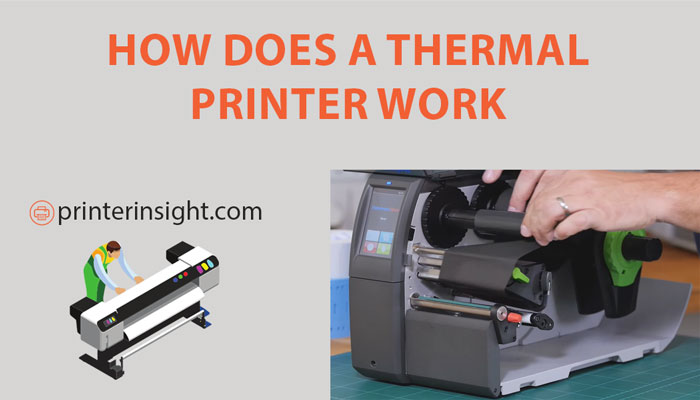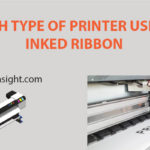We all have seen medical specialists using labels on testing tubes about specimen details, the receipt of the super shops, and identification stickers on the volunteers. All these are printed by a thermal printer. But how does a thermal printer work?
We all have seen them in our everyday life, yet very few know about them. In this blog, we will discuss thermal printers, how long does thermal printer ink last, and much more.
- What is a thermal printer?
- What are the different kinds of Ribbons used in thermal transfer printers?
- Can regular paper be used in a thermal printer?
- How much does Thermal Paper cost?
- What paper size is used in a thermal printer?
- How do I change the paper size in my thermal printer?
- Can I color print in a thermal printer?
- Is a thermal printer durable?
- How to install my thermal printer?
- How long does thermal printer ink last?
- What is the price of a thermal printer?
- Final Word
What is a thermal printer?
A thermal printer is a printer that prints our day-to-day articles. As a kid, I have always wondered where the label and barcode stickers came from on the chocolates that I was buying.
Not only chocolates, but every grocery, household item, even clothes, jewelry, and medicine also have labels mentioning the price, name of the importer, and other details. All these are printed in a thermal printer.
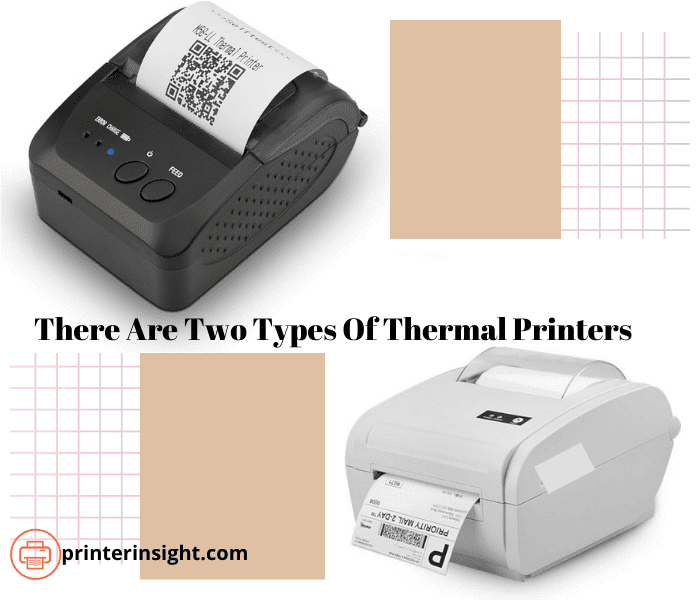
The prints that the thermal printer produces can withstand extreme weather conditions like exposure to sunlight and moisture. These printouts have greater longevity and will not be affected by their surroundings.
Thermal printers can produce high-volume prints and maintain similar quality printouts from the first printing till the end. This means you do not need to worry about smudged lines and fuzzy writings when you print in more significant quantities.
A regular printer (talking about laser and inkjet) can not be used to produce labels, signs, and barcodes, at least not the professional ones. But how does a thermal printer work, and why can’t regular printers create such articles?
How does a thermal printer work?
Printers and inks come hand in hand. But this is not the case for thermal printers. So how does a thermal printer work without ink cartridges? These printers produce writings using heated printheads.
However, different kinds of thermal printers use ink ribbons that are heated to the point that the ink ribbon melts and produces printed articles. You must be wondering how long does thermal printer ink last? We will dig into that shortly.
There are two types of thermal printers, and their way of work is unique. However, their printing results are quite similar and produce vivid, prominent markings. The two types of thermal printers are Thermal transfer and Direct thermal printers.
Are you looking for answers about laser printers? Here is a blog to help you out- ‘Do Laser Printers Use Ink? – Everything You Need To Know.’
What are the different types of the thermal printer?
As mentioned above, there are two types of thermal printers, and here we will discuss both.
Direct thermal printers
Direct thermal printers do not need ink ribbons or ink cartridges to work. They never run out of ink and can produce as many printouts as you want without any interruption.
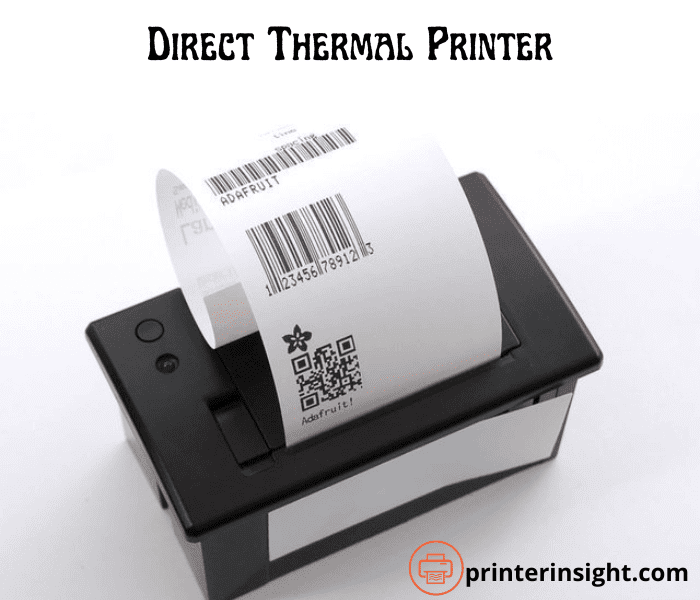
The printer uses unique papers that, when heated, prints directly onto the medium without any external ink. The printer has a printhead that gets warm and reacts to the chemicals in the paper, and produces printouts.
Direct thermal printers are less costly than thermal transfer printers. However, the chemical reaction when in contact with heat makes them less durable. If you keep your label out in the sun or heat, moist places for a long time, the writings or signs will fade.
These types of thermal printers are commonly seen in superstores or any retailer shops to print receipts. There are several sizes of thermal printers for any shop, from large to small. You can even get a BlueTooth printer, portable printer, etc.
Thermal transfer printer
Thermal transfer printers use ink ribbons to create printouts. As they are not directly dependent on heat, the printouts are durable, and the result can last up to a year.
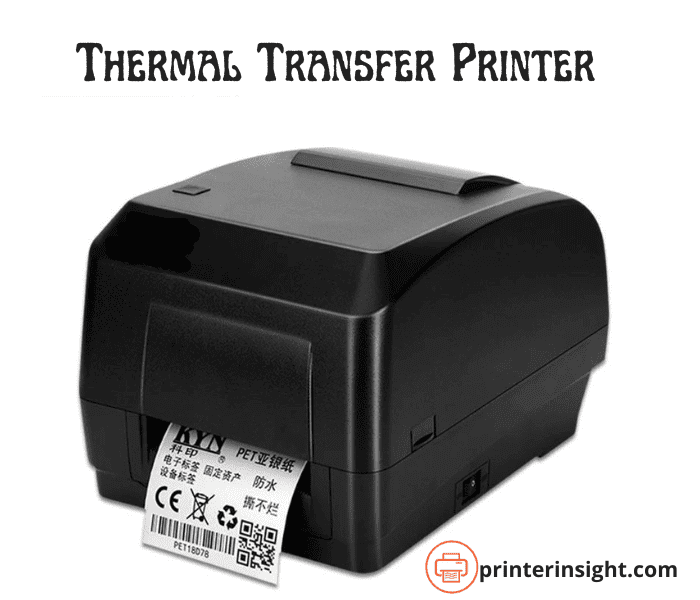
Thermal transfer printers are commonly used by shipping companies and by any industry that labels its goods. These printers are used to print barcodes, product manufacturing, expiry date, importer and distributor details, etc.
The printers do not use standard ink, and they are pushed into the paper; hence they can retain their quality and vividness regardless of the weather condition or surroundings.
What are the different kinds of Ribbons used in thermal transfer printers?
There are three types of ribbons used in a thermal transfer printer. These are- full wax ribbons, wax-resin ribbons, and resin ribbons. Let’s see what the differences are-
- Wax Ribbons
Wax ribbons are the most affordable ribbons for your thermal transfer printer. They contain 7 to 10 percent resin with the vital component, wax. They are moisture-resistant and create a permanent imprint that is rich, black, and clear.
These ribbons can print at a lower temperature. However, they are not immune to scratches, higher temperatures, or regular wear and tear.
There are cheaper versions of wax ribbons available in the market that contain little or no resin at all and are highly susceptible to damage, and it is not recommended to use in most cases.
- Wax-resin Ribbons
Wax-resin ribbons have 50-50 percent of wax and resin. They have an excellent level of scratch and smudge resistance, can withstand rough handling and abrasion, and can also absorb UV rays.
The results can last for a long time, and their prints do not fade or streak even in fluctuating weather conditions.
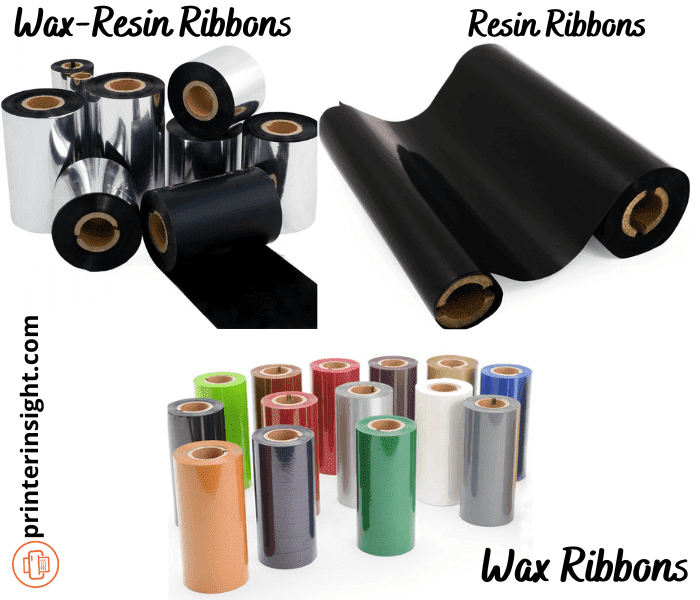
- Resin Ribbons
Resin ribbon is the most durable ribbon material for thermal transfer printers. They are 100 percent resin and produce dark and sharp images. They are durable and have a higher heat absorption capacity than others.
Resin ribbons are used when industries label things permanently or if the goods are made to go through extreme conditions. Resin labels have a transparent look and hence can be easily identified.
Can regular paper be used in a thermal printer?
No, you can not use regular paper for thermal printers. As the thermal printer prints by activating the chemical with heat, there are special papers called thermal papers that are used to do the job.
Thermal papers are more pricey than standard papers as these papers have the mechanism to print images without ink. However, a direct thermal printer does not use the same papers as a thermal transfer printer.
Here is a guide for you to know how to reprint a shipping label on eBay-
How To Reprint A Shipping Label On eBay
Paper used in Direct Thermal Printer
The paper used in direct thermal printers has inkless mechanisms and contains heat-sensitive pigments. These pigments, when in touch with the hot printhead, create images. E.g., receipts.
The papers used in direct thermal printers can oxidize with time fading the writings on the paper. However, this happens after a certain period and does not hamper your day-to-day printing activity.
Paper used in Thermal Transfer Printer
Thermal transfer printer prints with thermal papers that are designed to seep in ink from the heated thermal ribbon.
When the paper is installed, it sits beneath the thermal ribbon, and as soon as the printer starts working and the ribbons are melted, the paper imprints your desired images. E.g., shipping labels, barcodes, etc.
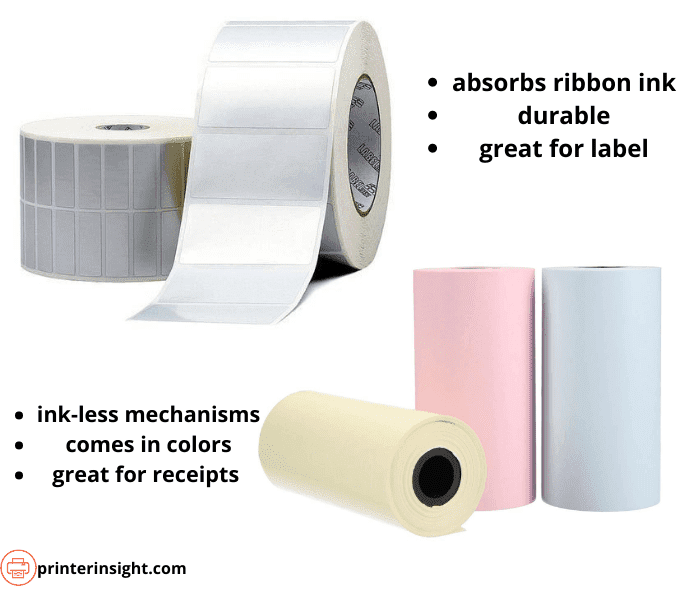
How much does Thermal Paper cost?
Thermal papers can come in various sizes and types, depending on your printer type and model. The cost of your thermal paper also depends on how long your paper roll is. Their core size, diameter, and width also play a role in the cost of your thermal paper.
Check out the latest prices of thermal papers on Amazon.
What paper size is used in a thermal printer?
Many companies and individuals use thermal printers for diverse needs. These printers are used by small companies as well as multi-million dollar industries. Naturally, the printer sizes are also different.
Some different types of Thermal Printers are-
- Mobile printers
- Desktop printers
- Industrial printers
- Print engines.
As a result, the paper sizes used in thermal printers are also different. However, choosing the right thermal paper with an accurate measurement matched with your printer is essential.
Even a half-millimeter can interrupt your printing process. Hence, understanding the size of your printer is essential. You can check the product manual to understand your printer and to know how a thermal printer works.
The product brochure will further mention your printer’s specification and paper size. If you do not have these. You can search your printer model on Google to get recommendations on the specific paper type and size.
How do I change the paper size in my thermal printer?
Although I have also wished the same, unfortunately, there is no way you can change your paper size in your thermal printer. In my early printing days, I, too, wished to print various sizes of pages in one desktop thermal printer.
Given that it was my first thermal printer, I had higher hopes. Unfortunately, you have to buy different sizes of thermal printers to print different sizes of paper.
Looking for the best sticker paper for your inkjet printer? Here is a guide to help you ‘Best Sticker Paper For Inkjet Printer – An Appropriate Guideline To Buy Your Suitable Product.’
Can I color print in a thermal printer?
I wish I had found some helpful blog like this to satisfy my curiosities back in the day. As for the longest period of time, I knew thermal printers were all monochrome (black and white).
However, manufacturers have come up with colored ribbons to print in your thermal printers. Yes, they are for thermal transfer printers, and there is still no technological development to print colors in direct thermal printers (although I’m still hopeful, fingers crossed).
You can find colored ribbons in all three types (wax, wax-resin, resin), although most colors are available only for wax and wax-resin. Only a few standard colors are found for full-resin ribbons.
Is a thermal printer durable?
Yes, thermal printers are durable. They have a good reputation, and I have even seen thermal printers last as long as 20 years. However, you need to use good quality paper and, in the case of thermal transfer printers, good quality ribbons to have a loyal printing pal for years.
With good care and a little love (like in most relationships), your printer can stay by your side for at least 7 to 10 years.
Figure 6- Industrial Thermal Printers
How to install my thermal printer?
Thermal printers are easy to install. Nowadays, wireless thermal printers are also available, which allow you to print from your smartphone or any other devices connected to the same network.
First, let’s find out how to install your thermal printer on your Windows PC. Here is a step-by-step guide-
- Connect your thermal printer to your laptop or desktop using the USB port provided by the printer.
- Switch on your printer.
- Open Settings on your PC.
- Click on devices.
- Click on “Add a printer or scanner.”
- At this point, your PC will automatically detect your printer. Click on the name and follow the steps to complete the installation.
- If not, select the ‘The printer that I want isn’t listed’ link, and Windows troubleshoot will guide you to find your device.
- Next, you will be directed to your printer’s company website to install the driver and installation tools.
- After that, follow the on-screen instructions to complete.
Note: If your PC does not direct to the printer’s website, you can directly go to the website and download the driver and tools to proceed with the installation.
Want to go wireless? Do not worry; here are the steps for you-
- Turn on your printer, and from the LCD, connect the printer to your WiFi.
- Your device will automatically find your printer and add it in the ‘printers and scanners’ section.
- Your printer is installed and good to go.
Note: If your PC does not automatically find your printer, you might have to connect your printer to your PC with the USB cable temporarily for installation.
How long does thermal printer ink last?
As discussed above, a direct thermal printer does not require ink to operate; hence the answer is unlimited. You can print for as long as you want with your direct thermal printer without worrying about your printer ink.
For the thermal transfer printer, the ribbon longevity depends on the usage. However, it can last around 6 to 8 months.
What is the price of a thermal printer?
This question can not be answered in one word since there are way too many types and variations of thermal printers. From industrial to pocket thermal printers, the prices are vastly different.
You can check the latest price on Amazon.
Final Word
I hope I was able to satisfy your queries on how does a thermal printer work. If you own a small business, this machine can put your professionalism into perspective. As for established enterprises, a thermal printer is a necessity.
There are various thermal printers available in the market at different prices. Select the one that satisfies your requirements within your budget.
